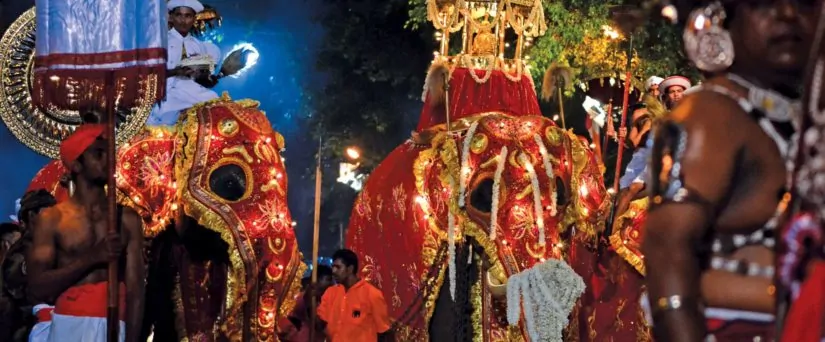At this historic temple a procession known as “the Duruthu Perahera” is held on the pre-full moon poya day of the month of Duruthu (January) every year. On this occasion, hundreds and thousands of people from all parts of the country, and hundreds of foreign tourists trek their way to the temple purlieu to witness this spectacular pageant. All the roads around Kelaniya on this day seem, as it were, to lead to Kelaniya and nowhere else.
The procession, by itself, is a ritual depicting the nation’s age-old religious customs and ceremonies. It displays the ancient traditions and the cultural heritage of the country. It demonstrates to the world the age-old traditional folklore, folk music and the rhythmic dance forms and drum beats which have developed throughout the ages around Buddhism and Buddhist practices in the island.
This great pageant popularly known as Kelani Perahera was first inaugurated in 1927. Its pioneer was Mr. Don Walter Wijewardene the most endeared son of Mrs. Helena Wijewardene of Sedawatte Walawwa (See page —-). At its inception, it comprised only two divisions – the Dhatu Perahera, conducted in homage to the Buddha relics and the Vibhishana Devala Perahera, held in dedication to God Vibhishana, the patron deity of Kelaniya. Later two other divisions were added, the first in 1930, in honour of God Vishnu, the patron deity of Sri Lanka and the second in 1954, in dedication to Skandha Kumara, the war-God and patron deity of Kataragama.

Hence the Duruthu Perahera today is composed of three separate processions that of the Buddha relics and those of the three devalas, Vishnu, Kataragama and Vibhishana. The Dhatu Perahera, being the foremost, always leads in honour of the relics and makes the three devala peraheras follow in their order of precedence, namely Vishnu, Kataragama and Vibhishana. Vibhishana, being the host God gives precedence to the other two Gods.
The Perahera, in fact, is the climax of a religious festival annually held at the temple to commemorate the Buddha’s first visit to Sri Lanka in the month of Duruthu or January. The religious festivities and ceremonies connected with this cultural ritual last over a period of about one month. It usually extends from the full moon day of December (Unduwap) to the full moon day of January (Duruthu).
The Duruthu Festival is celebrated in three stages. It commences with a series of sermons (Dharma Desana) held each night, followed by a week’s pirith-chanting ceremony (Paritrana Desana). Subsequently the ritual culminates in the famous procession, the Perahera. The Perahera is the highlight of the celebrations. It is held at night on three consecutive days, prior to the Duruthu full moon.
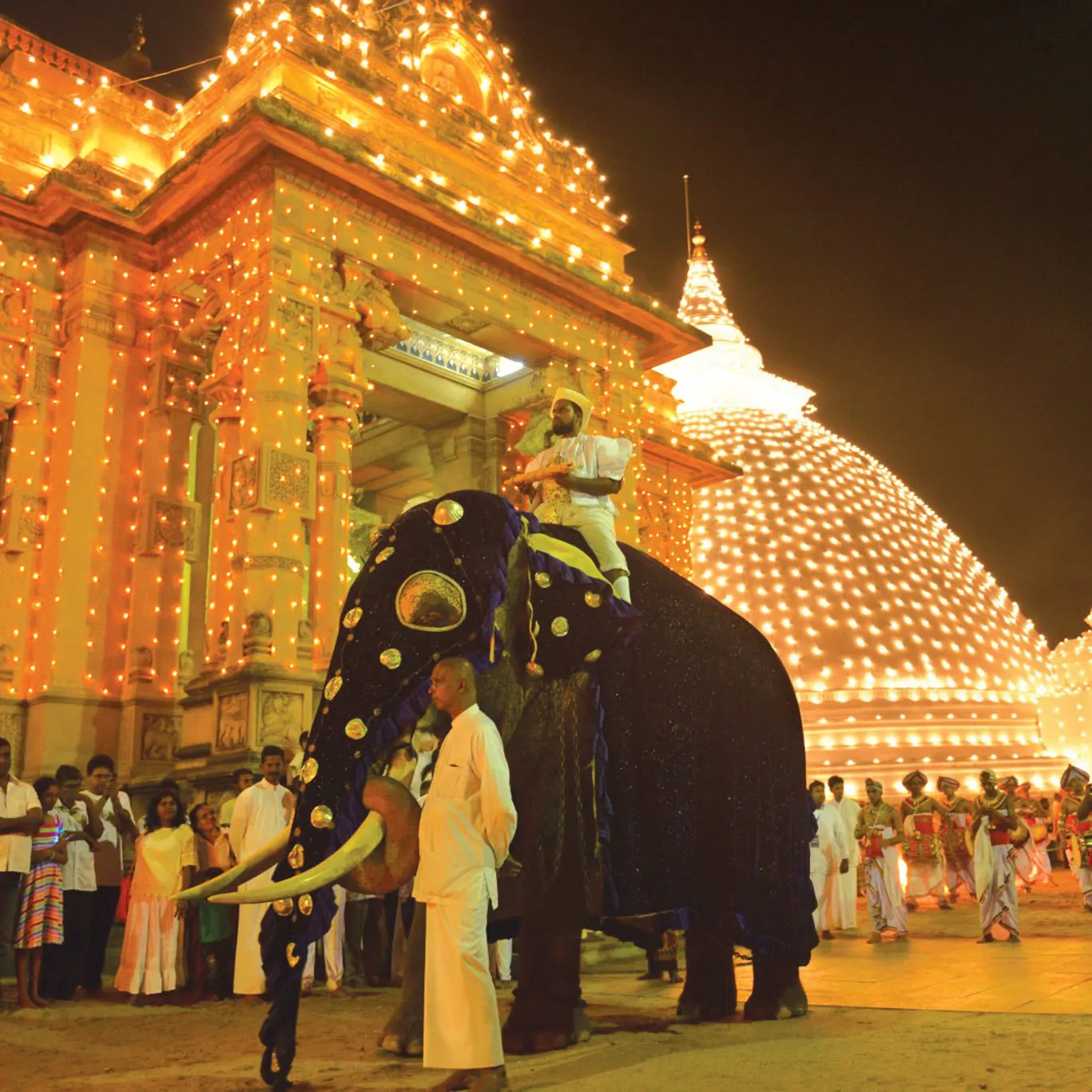
The first day Perahera, held on the upper temple terrace, is called the “Udamaluwa Perahera”. Each night before commencement of the perahera, customary rituals connected with it are performed in the arde – chamber of the Samadhi Statue and at the auspicious moment when the sacred casket is handed to the Chief Basnayake Nilame a cannon booms each night to announce the start of the perahera. On the first day of the perahera only the Dhatu Perahera is conducted and that too on a small scale. Only few elephants participate in it. As usual, flag-bearers, whip-crackers, fire-ball dancers, drummers and dancers too, take part, but in their small numbers. The Basnayake Nilames and the members of the Dayaka Sabha (the organising committee) walk in the procession attired in their white dress. The sacred casket placed on a colourful cushion, is carried by hand, in full reverence, by the Chief Basnayake Nilame or his Deputy. The Perahera, in this manner, perambulates the upper precincts of the temple, covering the area of the Sacred Bodhi-Tree, the Dagoba, and the Viharage or the image house. It makes three full circuits around and returns to the temple. The sacred casket is then replaced in its chamber.
The Second day Perahera is more colourful than the first, and is performed on a more extensive and elaborate scale. This time all the four composite divisions of the procession line up in their respective order. The Dhathu Perahera leads and the three Devala Peraheras trail behind and form the tail end. This time the procession takes to the streets of the lower temple square and is therefore called the “Pahata Maluwa Perahera”. The elephant carrying the sacred relic casket in the Dhathu Perahera and those carrying the divine insignia in the Devala Peraheras form the cynosure of each Perahera. The Basnayake Nilame and his retinue, in attendance, follow immediately behind. After making one circuit around the temple, the Perahera returns (gewadinava) to the temple.
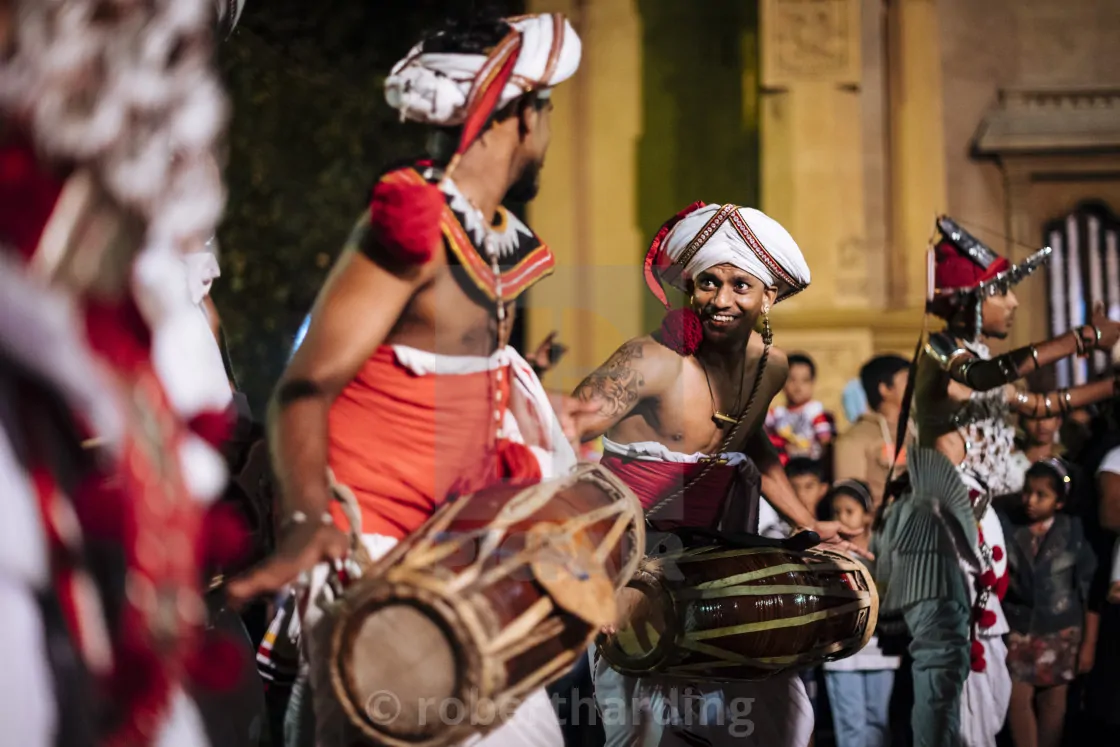
The Third and the Final Procession called the “Randoli Perahera” is the climax of the whole festival. It is usually held on the pre-poya day of the Duruthu moon. This is the most colourful and magnificent spectacle that the Buddhists of Sri Lanka look forward to with great fervour and enthusiasm.
Before the commencement of the procession, the divine insignia of the respective Gods are ceremonially conducted out of each devala amidst the beat-sounds of hevisi drums and are securely placed on the decorated howdah-like repository on the back of the respective tuskers. Then the ceremonies connected with the commencement of the grand procession are performed in the art chamber of the Samadhi Statue or the Samadhi Pilimage. The officiating monks and the Basnayake Nilames, led by the chief Basnayake Nilame assemble in front of the Samadhi statue, and wait in anticipation. Then the perahera rituals begin.
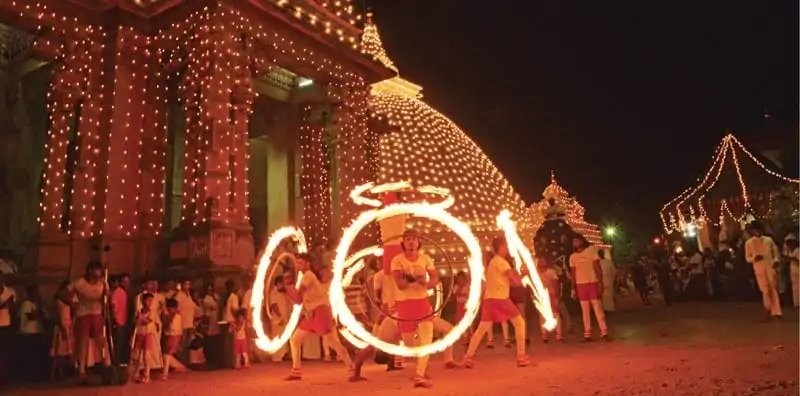
At the outset Pansil is administered. The Venerable Viharadhipathi Thera or the Priest Incumbent delivers a short address on the significance of the moment. Next the sacred conch is blown thrice in consecration, involving the blessing of Gods followed by the bearing of festive drums (Magul Bera). And then amidst the chanting of Seth Pirith the Viharadhipathi Thera hands over the sacred relic casket to the Chief Basnayake Nilame. At this auspicious moment a cannon booms to announce that the Perahera has commenced, from there the sacred casket is conducted out of the viharage by the Chief Basnayake Nilame with the traditional hewisi band and the troupe of ves-dancers performing in front. At the belfry, the sacred casket is placed in the decorated howdah, the gilded octagonal seat, set up on the back of the caprisoned tusker and the Perahera then begins to move forward down to the streets below.
Heading the procession, come the whip-crackers, in single row cracking their whips at regular intervals. They herald the approach of the Perahera. Next comes a group of fire-ball performers (gini-bola karayo). They parade the street in various formations, swinging and whirling hundreds of stringed fire-balls, making various patterns, and designs in the air. They are followed by an elephant carrying the national flag symbolising the nation. Next comes a group of standard bearers uniformly dressed. They march in two rows, carrying the colourful banners and the flags of the different districts and provinces (korala kodi and disa kodi). A troupe of hevisi drummers comes next playing different drum beats and dancing to their tunes. They are followed by an elephant carrying the Buddhist flag. Close behind march more standard bearers in two rows on either side. The elephant that comes next carries the Naga Kodiya, the flag of Kelaniya, followed by a group of standard bearers, and troupes of dancing drummers.
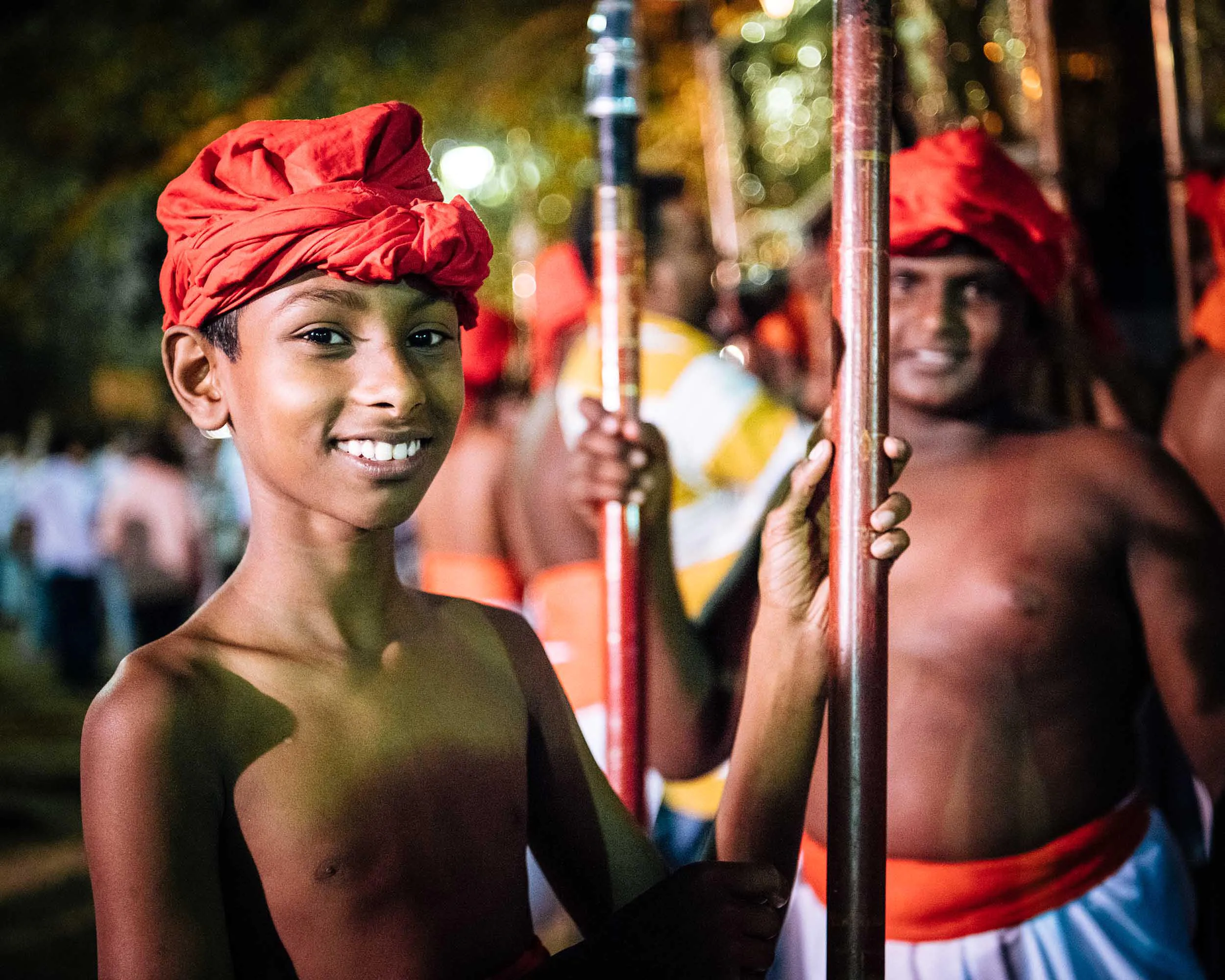
Mounted on his elephant, then comes the Peramune-rala, the frontiersman in his customary dress carrying in his hand the chronicles or the ‘lekammitiya’. He is followed by a troupe of dancers and drummers, beating their drums and dancing to the rhythm of the drum beats. Riding the next elephant is the Gajanayake Nilame, the chief in charge of the elephant stable. He carries in his right-hand a silver goad which is the symbol of his office. A row of elephants, in full panoply and array comes next. At intervals are seen troupes of dancers of various grades representing various schools of dancing in the hill country and the low country. After them comes the Kariyakarawana-rala, the master of ceremonies, attended by his retinue and-the drummers and dancers.
They are followed by two Buddhist monks, in their saffron robes, representing the Brotherhood of the Sangha and officiating here as the curators of the Buddha relics. Walking underneath the traditional yellow parasol, held over them, they pass on, pacing their path at an easy solemn pace.
Then comes the majestic tusker of noble birth carrying the sacred relic casket on his richly caparisoned back. He walks in all his majesty and dignity, pacing proudly the white carpet-cloth (pawada) spread on the floor of the road to receive his feet. It is indeed very surprising to see how he walks with solemn grace, fully aware of the sacred duty he is chosen to perform. He would not take a single step forward unless and until the white cloth is spread before him. Any delay in spreading the pawada would bring him to an abrupt halt. He is flanked by two other elephants. Two white-clad attendants riding on them strew fragrant jasmines on the sacred casket in reverential homage. Before the tusker goes a troupe of Kandyan ves-dancers dancing to the beat of drums, and singing verses of high praise.
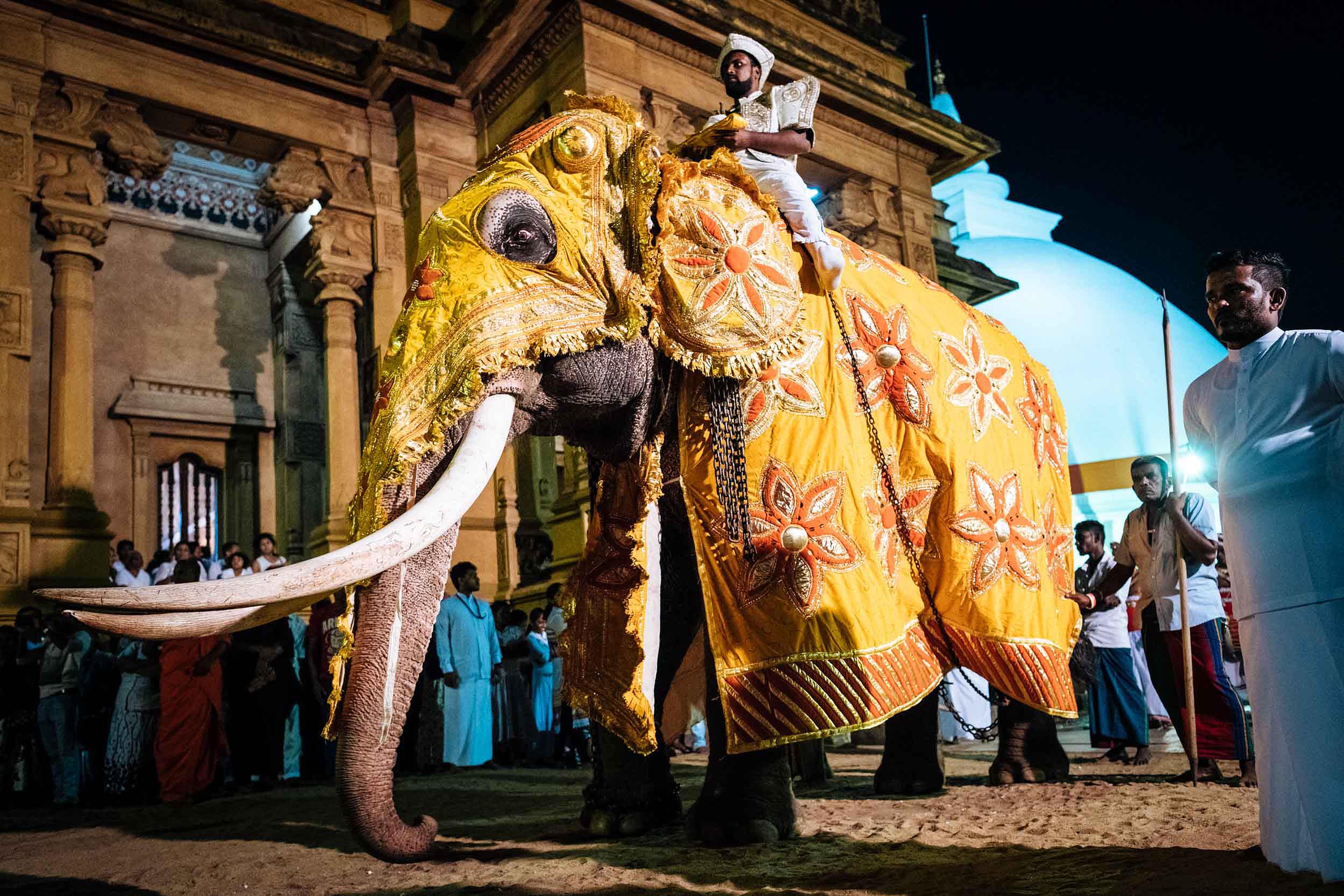
Behind the tusker under the colourful parasol held aloft comes the Chief Basnayake-nilame dressed in his princely Indian costume. He is the lay custodian of the sacred relic casket. He is attended by a troupe of ves-dancers in front and his personal entourage of vidanes and attendants in the rear. Clad in their customary Kandyan costumes these attendants carry their traditional spears (mura-ayudha) umbrellas (sesath) and tail pot leaves (tatatu).
The official dress of the Chief Basnayake Nilame of Kelaniya is different from that of the Diyawadana Nilame of Kandy.
The Dhatu Perahera, the main division of the Randoli Perahera ends here, at this point. The three devala Peraheras now follow in their respective order. The order of each Perahera is almost the same. The flag-bearers walk at the head followed by elephants in single file. Troupes of hevisi drummers and dancers performing various dance forms are added at intervals to maintain the choreographic balance of the Perahera. All the three principal schools of dance in Sri Lanka (Udarata, Sabaragamuwa and Pahatharata) are represented. Each devala Perahera ends with the devala tusker carrying the deistic insignia (devabharana) followed by the Basnayake Nilame, the custodian of each Perahera and his retinue of chiefs and attendants, all dressed in their customary costumes.
The entire length of the Perahera route is illuminated by torches carried at regular intervals. The Perahera in its prescribed order traverses the lower temple square and then winds its way on to the outer streets. The streets around are all decorated with colourful banners and flags. The Buddhist flag takes the pride of place and is seen flying at the top of the houses and the buildings on either side of the streets.
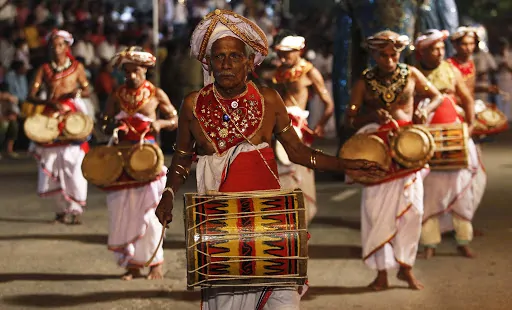
The tail end of the Perahera is characterised by three palanquins (randoli) of the devalas, carried by attendants of the respective devalas. A woman in attendance, clad in reverential garb walks beside each palanquin, fanning the palanquin with a chamara tail. In these palanquins are carried the ornaments of the respective Gods including the pitcher of each devala.
The Perahera, having traversed the entire length of the route now returns (gevadinawa) to the temple. The relic casket is now taken off the back of the tusker by the Chief Basnayake Nilame and is conducted back to the Viharage amidst the beat of hevisi drums, and is reverentially deposited in its chamber. At this moment a cannon booms to indicate the closing ceremony of the Perahera. The devala Peraheras return to their respective devalas. The devine insignia of each devale are similarly conducted back to each devale and are replaced in their former positions. All the Basnayake Nilames now gather at the relic chamber and perform the rites connected with the closing ceremony. After that they visit the Vibhishana Devala and pay obeisance to God Vibhishana and perform poojas in a form of thanking him for enabling the Perahera to be concluded successfully.

Thus runs the illustrious history of the Kelaniya Temple in bold letters through annals of history as recorded in ancient chronicles, rock inscriptions, literary works and age-old legends. Having been sanctified by the Buddha himself, in person, the place where the temple stands today is considered as one of the most sanctimonious spots in Sri Lanka. The temple itself was worshipped and renovated by kings, venerated and protected by the nobility and the common from times immemorial. It braved and withstood all those acts of hostility of the fanatic foreign invaders and heretic vandals during adverse times and hostile periods of history. Today it enjoys an enviable position in the cultural legacy of the island. Devotees and admirer’s from all parts of the country and distant lands trek their way here to worship the hallowed spot and admire its sculptural artistic beauty. In modern times it has therefore become ever more popular and attractive as a place of Buddhist worship and a tourist destination, especially during the month of January when the Duruthu Perahera takes place with all its pomp and pageantry.
